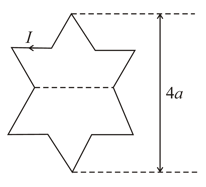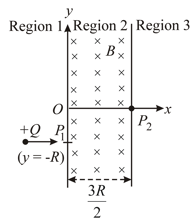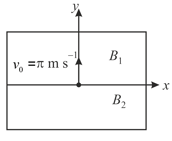A charged particle (electron or proton) is introduced at the origin with a given initial velocity. . A uniform electric field and a uniform magnetic field exist everywhere. The velocity , electric field and magnetic field are given in column and , respectively. The quantities are positive in magnitude.
Column-1
Column-2
Column-3
(I)
Electron with
(i)
(P)
(II)
Electron with
(ii)
(Q)
(III)
Electron with
(iii)
(R)
(IV)
Electron with
(iv)
(S)
In which case will the particle move in a straight line with constant velocity ?

Important Questions on Magnetic Effect of Current
A charged particle (electron or proton) is introduced at the origin with a given initial velocity. . A uniform electric field and a uniform magnetic field exist everywhere. The velocity , electric field and magnetic field are given in column and , respectively. The quantities are positive in magnitude.
| Column-1 | Column-2 | Column-3 | |||
| (I) | Electron with | (i) | (P) | ||
| (II) | Electron with | (ii) | (Q) | ||
| (III) | Electron with | (iii) | (R) | ||
| (IV) | Electron with | (iv) | (S) |
In which case would the particle move in a straight line along the negative direction of axis, (i.e, move along )?
A symmetric star shaped conducting wire loop is carrying a steady state current as shown in the figure. The distance between the diametrically opposite vertices of the star is . The magnitude of the magnetic field at the centre of the loop is

A uniform magnetic field exists in the region between and (region in the figure) pointing normally into the plane of the paper. A particle with charge and momentum directed along -axis enters region from region at point Which of the following option(s) is/are correct ?

In the -plane, the region has a uniform magnetic field and the region has another uniform magnetic field . A positively charged particle is projected from the origin along the positive axis with speed , as shown in the figure. Neglect gravity in this problem. Let be the time when the particle crosses theaxis from below for the first time. If , the average speed of the particle, in , along theaxis in the time interval is __________.

